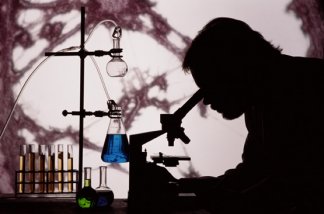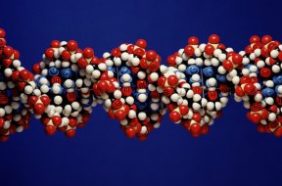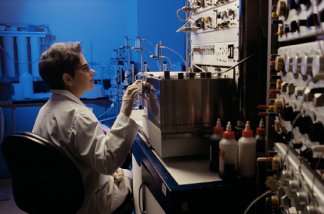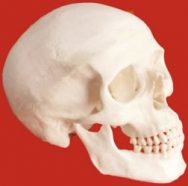Crime lab
From accidents to crime scenes, scientists are helping detectives solve mysteries.
By Emily Sohn
Suppose you’ve just been in a car accident. A sport utility vehicle slammed into your little sedan at high speed. After the impact, your vehicle spun around before crashing into a telephone pole. Luckily, no one was seriously hurt, but the SUV sped away before you had a chance to see its license plate. What do you do?
You’d probably wait for an ambulance to take you to the hospital to get checked out. Meanwhile, police officers would arrive at the scene. They’d talk to witnesses, examine skid marks, make measurements, take photographs, and collect shards of glass and other scraps. Then a team of forensic scientists would analyze the data for clues that could lead them to the vehicle (and driver) that hit your car.
 |
|
Microscopes and chemical equipment are important tools for forensic chemists, who must examine crime-scene clues.
|
Forensics is the application of science to solving crimes, and scientists are getting really good at it. “There’s no such thing as getting away without a trace,” says Jose Almirall. “There’s always evidence left behind.” Almirall is an analytical chemist and associate director of the International Forensic Research Institute at Florida International University in Miami.
You may have heard of (or even seen) adult TV shows such as CSI: Crime Scene Investigation. This program and others like it have sparked widespread interest in the tricks and techniques that scientists use to solve legal puzzles.
Forensic biologists analyze blood, hair, and saliva to identify criminals. Forensic chemists look at powders and other materials for traces of drugs or explosives. Forensic anthropologists study bones to estimate how old people were when they died. There are even forensic meteorologists who track weather patterns.
“The field is constantly changing,” Almirall says. “That’s why research is important. We’re always improving the technologies.”
These new methods and technologies mean that getting away with a crime is becoming harder and harder to do.
Ancient history
The first recorded reference to forensics comes from a book written in China in 1248. The book, called “Hsi Duan Yu” (which means “The Washing Away of Wrongs”) explained how to tell the difference between a person who has drowned and a person who has been strangled.
By the mid-1800s, chemists could identify poisons inside a person’s body. In 1892, Englishman Francis Galton provided the first scientific evidence that everyone’s fingerprints are unique and could be used as evidence. Now, fingerprints are one of the first things detectives look for at the scene of a crime.
Whenever a researcher in any field develops a new technique, forensic scientists look for ways to apply it in their own work.
 |
|
A piece of a model of a DNA molecule showing its twisting structure. Each ball represents an atom.
|
For example, every cell in a person’s skin, blood, saliva, or other body part contains a molecule called DNA. No two people (except identical twins) have the same DNA. In the 1980s, biologists figured out how to use DNA as a sort of molecular fingerprint. Since then, DNA testing has become the clincher that often makes or breaks a case (see Baby Swaps, Crime Scenes, and DNA Testing).
Technology alone won’t solve a mystery, however. Forensic scientists also have to be clever, and any object is a possible clue.
Evidence can include saliva left on a chewed pencil or the back of a stamp. A dog’s saliva can prove that the dog bit someone. DNA in lumber can be traced back to a tree that was illegally cut from a protected forest. Hair has DNA. So do skin cells that flake off our bodies all the time.
“We have a specialized vacuum cleaner that concentrates such evidence onto a pad,” says Almirall. “We can look on the pad for cells.” Anyone who’s been in a room leaves such traces without knowing it.
Body farm
Piecing clues together to solve puzzles is the fun part of forensics, Almirall says. Visiting crime scenes is tougher.
“It’s not as glamorous as you might think,” he says. “On TV, they make it look cool. But that’s a very unpleasant experience for me.”
 |
|
Lab work plays an important part in analyzing clues and solving crimes.
|
(If you’re squeamish, you might not want to read the next section.)
Forensic science can be as gruesome as the crimes it tries to solve. Detectives sometimes find a body in the woods, for example. They have to figure out who that person was and what happened to him or her. If the body has been there long enough, it might be unrecognizable.
To tackle problems like these, researchers in Tennessee turn to a unique outdoor lab often called the “body farm.” A fence surrounds the 2-acre plot of land, which is hilly and full of trees. Inside, more than 40 bodies lie in various stages of decay. Scientists watch the bodies closely to see what happens to them over time at the hands of weather, raccoons, bugs, and other disturbances. These observations help them learn how to interpret what police find in the field.
“We only recently started to understand the complex phenomenon by which we revert back to the dust from whence we came,” Arpad Vass says. Vass is a forensic anthropologist at the Oak Ridge National Laboratory in Oak Ridge, Tenn.
“Understanding decomposition can help us answer the ‘W’ questions,” he says. “When did they die? Where did they die? What happened? Who’s the victim?”
Skeleton key
When only bones are left, it takes a different approach to answer those questions.
Not far from the body farm, in a lab at the University of Tennessee in Knoxville, forensic anthropologist Richard Jantz stores a vast set of human skeletons. The donated collection contains some 500 examples, with about 50 more added every year.
 |
|
Analyzing skulls and other bones can provide clues about how someone died—and about how a person lived before death.
|
In his lab, Jantz measures skulls, takes three-dimensional images, and analyzes wear and tear to learn things about bones. Such information provides clues about how old people were when they died and the kinds of things they did when they were alive.
Jantz can also tell what people ate and sometimes where they lived, based on chemical analyses of their skeletons.
This kind of information is useful when scientists uncover bones in mass graves or find ancient fossils. It also helps them understand disasters, such as plane crashes, and historical mysteries, such as the 1937 disappearance of aviator Amelia Earhart.
“Forensic anthropology has grown dramatically in the past 20 years,” Jantz says. Jantz’s bone collection is an important resource.
Strangely enough, his lab is tucked beneath UT’s football stadium, which holds as many as 107,000 spectators at each game. “I don’t think 99.9 percent of them know what they’re sitting on top of,” Jantz says.
Wide field
Forensics is about more than just gore, bones, and blood. It also helps keep us safe.
If you’ve ever been to an airport, you may have seen an official wipe your luggage with a swab, put it in a machine, and then have you walk through a metal archway. Forensic chemists invented the machine to catch people who are carrying explosives. It works by using air puffs to dislodge any particles attached to you. Then, it analyses these particles for dangerous substances.
Instruments that are even more sensitive are in the works, Almirall says.
Another recent invention uses specialized software to match a document with the printer that spit it out. The inventors, from Purdue University in West Lafayette, Ind., are working with U.S. Secret Service agents to apply their new technique. They hope it will help them find the sources of items such as counterfeit money and fake airline boarding passes. This could help them catch terrorists or other criminals.
 |
|
Images made by printers can include imperfections, such as the light and dark bands seen in this example. Because every printer has its own pattern of banding, it’s possible to trace documents to the printer on which they were printed.
|
| George Chiu, Purdue University School of Mechanical Engineering |
The field of forensics is so broad, Almirall says, that learning it takes a long time. You normally need degrees in more than one science, along with medical knowledge. Then you need to learn how to apply that information at crime scenes.
When you’re done with all the studying, though, you’ll be a different sort of scientist. You’ll often find yourself in strange situations, at crime scenes or in front of juries. You’ll interact with lawyers, judges, investigators, and scientists with all sorts of specialties.
“A typical analytical chemist doesn’t do these kinds of things,” Almirall says. “Anything can come into the lab as evidence. You don’t know what to expect. It’s not monotonous.”
In the end, you might help put dangerous criminals in jail. You might solve mysteries that have been around for decades. You might even save lives or bring peace to families who have lost a loved one. These are things that not every scientist gets to do.
Going Deeper:







